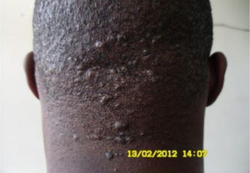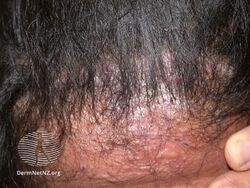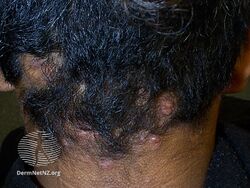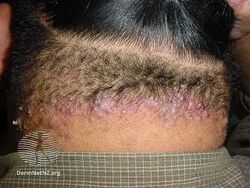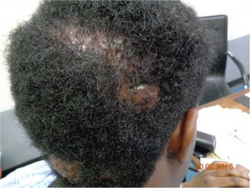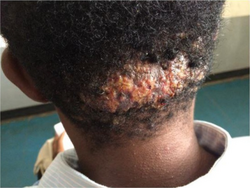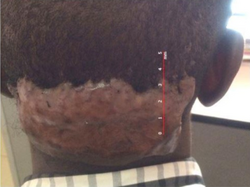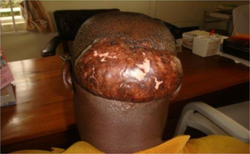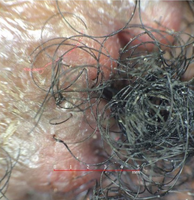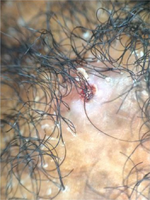Acne keloidalis nuchae
| Acne keloidalis nuchae | |
|---|---|
| Other names: Dermatitis papillaris capillitii, folliculitis keloidis nuchae, nuchal keloid acne[1]: 526 | |
 | |
| Small bumps on back of head and neck | |
| Specialty | Dermatology |
| Symptoms | Small bumps on back of head and neck[2] |
| Complications | Scarring, hair loss, bleeding during hair cuts, infection[3] |
| Usual onset | Typically within hours to days following a haircut[3] |
| Causes | Unknown[3] |
| Prevention | Safe shaving habits[3] |
| Frequency | Common,[3] males>females[4] |
Acne keloidalis nuchae (AKN), also known as folliculitis keloidalis and acne keloidalis, is a long-term inflammation of hair follicles, presenting with small bumps associated with scarring hair loss at the back of the head and neck.[2][4] It generally affects dark skinned young males of African, Hispanic and Asian descent.[2]
The cause is not fully understood but may relate to androgens and genetic factors.[3] Other factors that may trigger the condition include inflammation, infection, trauma, and ingrowing hairs.[3] Onset is typically within hours to days following a haircut.[3] Irritation from shirt collars, hats, helmets, and wooden combs may play a role.[3] Complications include scarring, hair loss, bleeding during hair cuts, and infection.[3]
The condition is generally common but rare in males older than 55-years.[3] Most occur in men of African descent, with a prevalence in Nigeria of 0.7% to 9.4%, Benin of 0.7%, South Africa of 4.7% in boys in their final school year and 10.5% in older males, and in African-Americans of 0.5% to 13.6%.[3]
Signs and symptoms
AKN is characterized by firm pink or flesh-colored, or hyperpigmented bumps in the skin, which are usually located at the back of the head and neck. This is mainly because men often cut their hair very short as opposed to women, allowing the hair to prick the occipital scalp thereby causing irritation. Acne keloidalis nuchae most commonly presents itself in individuals aged 13 to 25.[5] The disease is closely related to pseudofolliculitis barbae and both occur frequently in black men in the military, where it is so common that the US Army has developed official protocols for management.[6][7] Prolonged cases of AKN can cause keloid formation due to chronic irritation from folliculitis. Bacterial folliculitis and acne can mimic the appearance of AKN; however, unlike acne, comedones are not seen with AKN.[citation needed]
-
Varying size of bumps in AKN
-
Acne keloidalis
-
Acne keloidalis
-
Acne keloidalis
-
AKN with folliculitis decalvans
Complications
-
Infected AKN
-
Mistreated AKN
-
Keloid
Diagnosis
-
Loss of follicular ostia, tufted follicles, and papules
-
Tufted hairs with an area of loss of follicular ostia
Treatment
Treatments for AKN aim to reduce inflammation and prevent infections and scarring. Therapies for AKN may include topical antibiotics, topical or intralesional corticosteroids, and laser hair removal. Recommended modifications to shaving habits include liberal use of shaving cream, avoidance of stretching the skin while shaving, and use of a single-blade razor rather than a razor with multiple blades.[citation needed]
See also
References
- ↑ Rapini, Ronald P.; Bolognia, Jean L.; Jorizzo, Joseph L. (2007). Dermatology: 2-Volume Set. St. Louis: Mosby. ISBN 978-1-4160-2999-1.
- ↑ 2.0 2.1 2.2 James, William D.; Elston, Dirk; Treat, James R.; Rosenbach, Misha A.; Neuhaus, Isaac (2020). "13. Acne". Andrews' Diseases of the Skin: Clinical Dermatology (13th ed.). Elsevier. p. 242. ISBN 978-0-323-54753-6. Archived from the original on 2023-04-24. Retrieved 2023-04-24.
- ↑ 3.00 3.01 3.02 3.03 3.04 3.05 3.06 3.07 3.08 3.09 3.10 3.11 Ogunbiyi, A (2016). "Acne keloidalis nuchae: prevalence, impact, and management challenges". Clinical, cosmetic and investigational dermatology. 9: 483–489. doi:10.2147/CCID.S99225. PMID 28008278. Archived from the original on 2023-04-24. Retrieved 2023-04-24.
- ↑ 4.0 4.1 Oakley, Amanda (2014). "Folliculitis keloidalis. Acne cheloidalis | DermNet". dermnetnz.org. Archived from the original on 26 November 2022. Retrieved 24 April 2023.
- ↑ "Acne Keloidalis Nuchae". Archived from the original on 3 March 2011. Retrieved 15 March 2011.
- ↑ Pseudofolliculitis of the beard and Acne Keloidalis Nuchae (PDF). Technical Bulletin. Vol. TB 287. U.S. Army. Archived (PDF) from the original on 27 July 2018. Retrieved 30 May 2018.
- ↑ Brahe, Catherine; Peters, Kristopher; Meunier, Nicole (May 2020). "Acne keloidalis nuchae in the armed forces". Cutis. 105 (5): 223–226. ISSN 2326-6929. PMID 32603383. Archived from the original on 2023-04-24. Retrieved 2023-04-24.
External links
| Classification |
|---|
